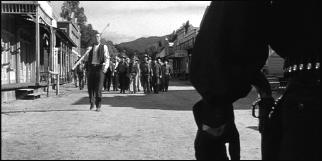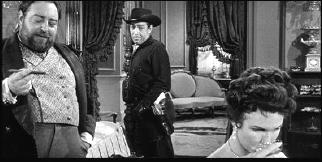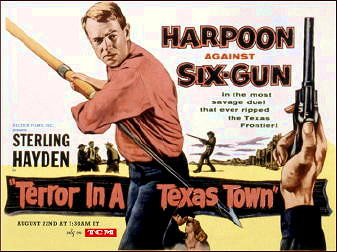Wed 20 Jul 2011
Reviewed by Dan Stumpf: TERROR IN A TEXAS TOWN (1958).
Posted by Steve under Reviews , Western movies[5] Comments
TERROR IN A TEXAS TOWN. United Artists, 1958. Sterling Hayden, Sebastian Cabot, Carol Kelly, Eugene Martin, Ned Young, Victor Millan, Frank Ferguson. Screenwriter: Ben Perry (as a front for Dalton Trumbo). Director: Joseph H. Lewis.
Mention of Nedrick Young [in my previous review ] may have baffled some of you out there, so I should say he was a sometime-actor/sometime screen-writer who wrote Jailhouse Rock and won an Oscar for The Defiant Ones, which he had to accept under a pseudonym because he was black-listed.

He also appears uncredited and disguised by a heavy beard in House of Wax (1953) but Young’s chief claim to fame is his portrayal of the sympathetically loathsome gunfighter in a little cheapie called Terror in a Texas Town (1958).
This was the last feature film of director Joseph H. Lewis, and a fitting cap to a career that started out in B-westerns and veered through such films as Gun Crazy and So Dark the Night. Terror moves with that manic intensity sometimes seen within the febrile reaches of desperate cinema, parading its clichés like a magician doing card-tricks, flashing one at us where we expect to see another, till the whole thing speed-shuffles itself into one of the most bizarre shoot-outs in the movies.
In all this delirium, there’s little time for serious acting, which is why it’s surprising to see some very nice turns here from thespians whose careers were mostly marginal. Sterling Hayden does a very creditable job as a Swedish sailor (a thematic echo of John Wayne in The Long Voyage Home) out west to join his father who has bitten the dust, courtesy of gluttonous Land Baron Sebastian Cabot.

Someone named Carol Kelly plays a poignantly masochistic kept woman, whose keeper is the declining gunfighter Johnny Crale, played here by Nedrick Young.
Young somehow brings real feeling to a stock character here. Black-clad, with six-guns at his hips, he strides about with a weary grace, his balletic movements always somehow tired and over-practiced, as he goes through the motions of pleading with his victims not to make him fulfill his destiny, or begs his opponent to get closer for a fair fight.
That bit happens in the final confrontation in the middle of a dusty street, and it seems less a cliché than one would think, thanks to Young’s assured playing and Lewis’s vigorous direction.
Perhaps the performances stand out because director Lewis puts them in such stark relief. Or it may be just a matter of budget that there are no extras in this Texas town till the last reel. Whatever the case, Terror lingers in the memory as an authentically strange film and even a rather good one.

July 20th, 2011 at 3:58 pm
See also Mike Grost’s long detailed analysis of this film on his website:
http://mikegrost.com/lewis.htm#Texas
I’ve not seen this movie, but between the two reviews, I’m certainly encouraged to!
July 20th, 2011 at 7:36 pm
Steve,
Thank you very much for the link!
This is a very good review of TERROR IN A TEXAS TOWN. This film is every bit as strange as the review suggests. Especially in its finale.
This was the last of Joseph H. Lewis’ films for theaters. But he had a long television career after this, making at least 65 TV episodes. Many of these are terrific. These include 49 episodes of THE RIFLEMAN.
July 21st, 2011 at 9:32 am
The finale of TERROR IN A TEXAS TOWN was anticipated by ideas in a pulp magazine thriller, John K. Butler’s “Death on the Hook” (1937).
This story is available on-line at:
http://www.adventurehouse.com/PDF/Headquarters_Det_37.03_Death_on_the_Hook.pdf
Have no idea if anyone involved with the making of the film had seen this short story.
July 21st, 2011 at 7:35 pm
I kind of doubt it, but who knows. The story might have been read by somebody who remembered it. It makes for quite a visual image, one that would stick with you.
But the magazine itself is obscure, HEADQUARTERS DETECTIVE, and the story’s not a western, but a mystery novel that takes place along the waterfront, where a harpoon, while not common as a weapon, seems natural enough.
In the Old West, though, that’s bizarre!
July 26th, 2011 at 9:50 am
What a pleasure to read a Stumpf review! This is a film new to me, and I have no idea if I’ll ever watch it, but the concept is… intriguing.